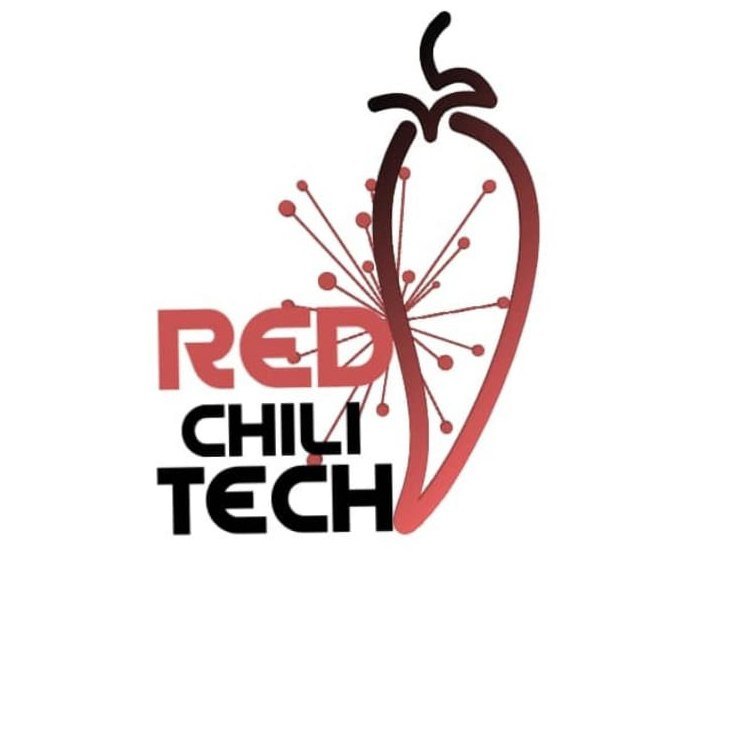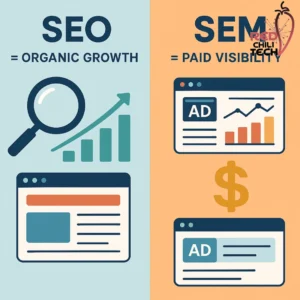What Is Digital Marketing? In today’s connected world, a physical storefront isn’t enough. Your business needs a powerful presence where your customers spend most of their time: online. This is where Digital Marketing comes in.
If you’ve heard terms like SEO, PPC, and social media and felt overwhelmed, you’re not alone. This complete guide from RedChiliTech breaks down exactly what digital marketing is, why it’s essential in 2025, and how your business can use it to grow.
Digital Marketing Defined: More Than Just a Website
Digital Marketing refers to all marketing efforts that use an electronic device or the internet. Simply put, it’s any form of marketing that exists online.
Unlike traditional marketing (billboards, print ads, direct mail), digital marketing allows you to track results, target specific audiences, and adjust your strategy in real-time.
The Core Shift: From Interruption to Connection
Traditional marketing often interrupts a consumer’s day. Digital marketing, especially in 2025, is about connecting with people exactly when and where they are looking for information, products, or services. It focuses on being helpful, relevant, and valuable.
The Key Channels of Digital Marketing (The 2025 Toolkit)
Digital marketing is not a single discipline; it’s an ecosystem of channels working together. Understanding these components is the first step toward building a successful strategy.
1. Search Engine Optimization (SEO)
What it is: The practice of optimizing your website and content to rank higher in search engine results (like Google and Bing) for specific keywords. The higher you rank, the more “free” (organic) traffic you receive.
- Why it matters in 2025: With the rise of AI-powered search, SEO is increasingly focused on creating high-quality, authoritative content that answers complex user queries completely and accurately.
2. Content Marketing
What it is: Creating and distributing valuable, relevant, and consistent content (like blog posts, videos, e-books, and infographics) to attract and retain a clearly defined audience.
- Why it matters in 2025: Content is the fuel for SEO and social media. As search engines become smarter, the demand for expert-level, original content is higher than ever.
3. Pay-Per-Click (PPC) Advertising
What it is: A model of internet advertising where you pay a fee each time one of your ads is clicked. The most common form is Google Ads, which places your business at the top of search results.
- Why it matters in 2025: PPC offers immediate visibility and allows for hyper-specific targeting (by location, interest, income, etc.), making it crucial for urgent lead generation or new product launches.
4. Social Media Marketing (SMM)
What it is: Using social media platforms (Facebook, Instagram, LinkedIn, TikTok, etc.) to promote products/services, engage with customers, and build brand awareness.
- Why it matters in 2025: SMM is now central to customer service and community building. Video content (Reels, TikTok) dominates, and successful brands focus on authentic, platform-specific engagement.
5. Email Marketing
What it is: Using email to promote products, nurture relationships, and build loyalty with your existing and potential customers.
- Why it matters in 2025: Despite all the new channels, email remains the highest ROI (Return on Investment) marketing channel. Personalization and automation are key to making it effective.
6. Website Development & UX/UI
What it is: While not strictly marketing, your website is the hub for all your digital efforts. UX (User Experience) and UI (User Interface) focus on making your site fast, easy to navigate, and mobile-friendly.
- Why it matters in 2025: Google prioritizes fast, high-quality websites. A poor user experience kills conversions, meaning all your marketing spend goes to waste.
Traditional vs. Digital Marketing: Why the Shift is Permanent
| Feature | Traditional Marketing (2025) | Digital Marketing (2025) |
| Reach | Mass market, general audience | Targeted, segmented, personalized |
| Cost | High (e.g., TV, print), unpredictable | Scalable, often lower, transparent ROI |
| Measurement | Difficult to track (e.g., “How many people saw the billboard?”) | Highly measurable (clicks, conversions, impressions) |
| Feedback | Slow, indirect (e.g., focus groups) | Immediate, direct (comments, analytics) |
| Adjustment | Slow, expensive (e.g., re-print ad) | Real-time (A/B testing, budget shifts) |
Getting Started: Your Digital Marketing Journey with RedChiliTech
The best way to start is not to try and do everything at once.
- Define Your Goal: What do you want to achieve? (e.g., more leads, higher sales, better brand awareness).
- Understand Your Audience: Where do they spend time online? What problems can your business solve for them?
- Choose 1-2 Channels to Master: Start with SEO and a primary social media platform (like Instagram for visuals or LinkedIn for B2B).
- Measure and Adjust: Use tools like Google Analytics to see what’s working and refine your strategy.
At RedChiliTech, we specialize in helping businesses build a cohesive, results-driven digital presence. We take the complexity out of the 2025 digital landscape, so you can focus on running your business while we handle your growth.
Ready to stop guessing and start growing? Contact RedChiliTech today to discuss a digital strategy that works for your business.

